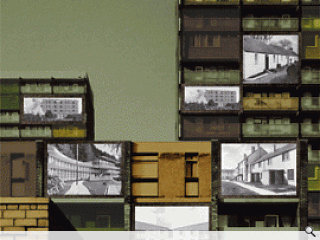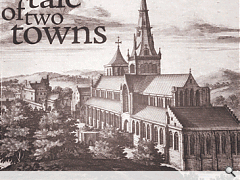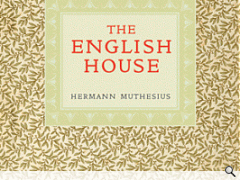Reviews
27 Sep 2007
Exhibition. Gordon Murray reflects on the last 70 years of housing design in Scotland. Can we recapture the ambition expressed in the very best post-war developments?
The Saltire at Seventy supplement in the last issue of Prospect was uplifting and one of the finest collaborative pieces of research into architecture in Scotland in the last decade. It made the same impact on me as Rebuilding Scotland – the RCAHMS volume edited by Miles Glendinning, reminding everyone that in post-war Scotland we had a period of heroic architecture. And bloody good it was too. Heroic in the sense of experimental, pushing boundaries, and investigating futures. One only need examine the statistics to realise the imperative; 93,000 units completed in the 1940s alone, a quarter of what was achieved in the 1960s. Yet an average per decade of just over 270,000 units in both public and private sectors, a similar imperative exists today. Look no further than the recently published Housing Task Force Report –The Scottish Housing Market Review. From this, it appears that Scotland’s provision in the year 2000 was 50% per thousand of population greater than the rest of the UK. Annual new build starts in Scotland over the last decade have been consistent at just over 20,000 units. In the same period, the average house price has doubled.
In England the rate of supply is on average 10-15% below the rate of household formation. In Scotland supply is not the problem – it is affordability and mobility. However, with housing and homeless charity Shelter calling for 30,000 affordable new homes, complex cost and supply modelling in this report suggests that doubling the annual new build would lead to a 10% improvement in levels of affordability, presumably by holding house prices static for longer. But such a move would substantially alter the supply profile. Yet current approaches fail to address the changing nature of households and family in the 21st century, although some housing developers are engaged on research into this. Nor do they respond to the requirements for mobility across housing types as individuals adapt to life changes.
Although I spent only a brief period in his office in the mid 1970s, Richard Moira was a great influence on me as a young architect. His criticism of government policy as quoted in the 1977 Saltire report read: “There is no opportunity to experiment with new plan forms to satisfy the detailed requirements of a society emerging from poverty into a certain affluence, or to allow the individuals of society to express their own wishes as to the distribution of shape of gardens, round and fitting.” This seemed to echo Reyner Banham 20 years earlier in the disparity between the prevailing ideas of architecture and the increasingly fluid social and class structures of the new Britain. “We still have no formulated intellectual attitudes for living in a throwaway economy. We insist on aesthetic and moral standards hitched to permanency, durability and perennity.”
He suggested encouraging architects to embrace genuine technology in order to promote social and cultural progress in which the concepts of change and expendability through advanced technology might be used by architects to challenge traditional architecture culture.
Cedric Price, with his Fun Palace and Potteries Thinkbelt, encapsulated this thinking. They were not buildings in a conventional sense but were instead highly adaptable to the shifting cultural and social conditions of their specific time and place – what Stanley Matthews in his biography of Cedric Price (From Agit-Prop to Free Space) calls “a new architectural paradigm of choice, ambiguity and indeterminacy”. Price’s conviction was that the responsibility of the architect was not to build eternal monuments but simply to provide easily adaptable living environments for the present and immediate future. Nothing new here. In 1928 Buckminster Fuller unveiled his 4-D timelock “lightful” towers which proclaimed “the need for a new kind of architecture, an architecture based on time, the fourth dimension of Einstein’s Relativity Theory”. This was his manifesto – a response to the need for mass-produced housing using the most modern materials. Similarly, speaking of Japanese houses a few years later after visiting Katsura, Bruno Taut observed “they are not human ideas and conceptions deliberately solidified in order to sell an eternal existence, but rather the projection of a moment into the universe. They stress the refinement of the transitory”.
Richard Moira and fellow Saltire panel member Anthony Wheeler were prescient when, in 1977 they suggested little evidence of science or art contributing to the advancement of housing design. I would suggest we have only recently begun a recovery from that hiatus. With the government pledging to deliver and the private sector increasingly seen as the delivery vehicle, the vast majority of housing design needs to be a heroic affair again. The German architect Christoph Ingenhoven in his book Energies is clear on the options: “We have only two alternatives in the matter of building. We can fake the past, or we can industrialise the future. The first is impossible because the past cannot be built again – certainly not when traditional craftsmanship is all but extinct. But, by the same token, industrialising the future will only work if we are able to attain a precision and complexity at least as impressive as what was achieved by the trained craftsmen of the past.”
If we start to think in unit volumes of more than 100 dwellings and consider advances in prefabrication technology (which only becomes economic in high volumes), we can start to match some of the housing volumes and quality being achieved in Scandinavia and Germany which – rather than being a pejorative leftover of the 1960s – can be rich and inventive. With the young British practice BACA beating off competition from Meccanoo and Kees Christiaanse to design a pilot scheme for 80 to100 floating homes in Dordrecht, Holland, there are signs of something interesting beginning to happen. Something that might appeal to Fuller or Price or even Richard Moira. Now if only this could be tied to riverside regeneration…
Gordon Murray
English house
Only a small handful of architecture books can justify the claim to be truly seminal but Hermann Muthesius’s comprehensive ‘Das Englische Haus’ (1904-05) is one such tome. It single-handedly “changed the course of European architecture” and is generally regarded as the ‘bridge’ between our Arts and Crafts movement and Germany’s faltering steps towards a resolutely Modern Movement.
As a student, in thrall to the work of Charles Rennie Mackintosh, I happened upon the abridged version (published as a single volume in 1979) in the basement of James Thin’s bookshop. It is only now that the complete book is available as a three volume facsimile edition. Both publisher Frances Lincoln and editor Dennis Sharp must be congratulated on realising such a long-cherished ambition.
Muthesius (1861 –1927) was a remarkable individual and used his privileged position as a Prussian attaché in London to undertake seven years of research into the minutiae of the English and Scottish house. He recognised how architecture could condition the character of the inhabitant and consequently championed this architecture because of its restraint and subtle orchestration of the domestic realm.
Mark Cousins
A tale of two towns
As one of several ‘initiatives’ to promote Glasgow’s Local History and Archaeology Working Group, Neil Baxter has done a creditable job of collating information on the buildings around Glasgow, principally around High Street and Glasgow Cathedral.
Several authors contribute to A Tale of Two Towns – including Dr E Patricia Dennison, Professor Michael Lynch, Dr James Macaulay and poet Donny O’Rourke – and take the reader through a quite marvellous history of one of the Europe’s most charismatic cities.
As stated in the opening pages, “A good deal of imagination is needed for the citizen of modern Glasgow to envisage the city or its inhabitants six or seven hundred years ago”. Certainly, any Glaswegian will have a much better perception of Glasgow life all those years ago as a result of reading this book, with several excellent pictures, maps and illustrations presenting the changes to Glasgow as the city grew around the Cathedral and High Street. It’s quite amazing to look at these and still see the basic layout of the area as it is today. This is an extremely worthwhile experience of a book that will interest anyone who knows Glasgow well and is interested in a city that truly has a fascinating archaeological history as it has developed and grown.
Stephen Lepitak
|
|





